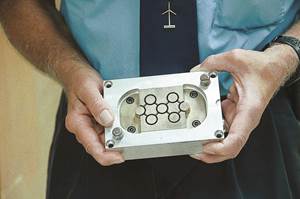Level Your Press in an Hour or Less
Injection Molding Know How
A level injection molding machine is necessary to keep producing high-quality parts. Here's how to do it right.
Your injection molding machine is leveled on installation, but how long does it take for it to drift out of level? How often should it be checked or re-leveled? For that matter, why bother leveling it in the first place? Isn’t the machine’s frame strong enough to keep things aligned?
Unfortunately, regardless of age, your machines need to be level to keep the platen parallel and the parting line of the mold in good shape—in other words to keep producing consistent, high-quality parts.
Let’s start with why the machine needs to be level. Upon clamp-up, the mold halves must mate perfectly and clamp evenly to keep the platen parallel and prevent flash, parting-line wear, and mold damage. If the machine is not level, the two halves of the mold will actually grind a wee bit on clamping, as they mate and reach tonnage. In fact, there will be a twisting motion as the two halves mate, and you’ll get parting-line wear. When the parting line wears and/or vents get peened shut, you’ll get flash, cosmetic blemishes, and/or burns on the part. Parting lines wear in normal production, but a machine that’s not properly leveled will accelerate the issue.
Part problems caused by an out-of-level machine often are not seen right away and are misdiagnosed when they are observed. Most processors will assume they are having an issue with the mold. They’ll bring the mold to the tool shop for redressing the parting line or for some other repair, only to put it back in the press and see the same part problems before the first or second production run is completed.
Do we agree now that it’s wise to have the machine level? OK, then how do we get it there…the first time? Usually it’s done this way: Someone places a machinist’s level across the tiebars near the stationary platen, and then levels the machine. Then the level is moved near the die-height platen, and the leveling feet are adjusted once more. Then the level may be placed parallel on a tiebar, with the leveling feet once again adjusted. Then each leveling position is rechecked, only to find that more leveling is needed. This approach can take hours, and still not yield the desired result.
Try another method: First, round up three machinist’s levels (yes, three), one torque wrench, and two people.
My suggestion is to buy a torque wrench and just one of the levels you’ll need. These things are expensive and most of the time just sit around. Try to find two other molders nearby with levels and borrow them when needed (and of course share yours).
Here’s my method:
1. Go to each leveling foot and clean and oil each of the leveling screws.
2. Of the two persons assigned to this task, pick the one with the most mechanical ability. Give him or her the torque wrench and get each of the leveling feet at the same torque. I wish I could tell you what number to shoot for but it varies with the type of leveling foot, weight of the machine, etc. The main idea is to get each foot to support about the same amount of weight. One needs a bit of mechanical sense to find the number for each machine/location. You might be surprised how level the machine is at this point.
3. Place one level across the tiebars (or guide ways, if they are supporting the platen), against the stationary platen. Place another level near the die-height adjustment platen, and the third parallel along one of the tiebars.
4. The person in the best position to see all three levels should now instruct the one who did the initial adjustment which feet to slowly move up or down until all three levels are level.
5. This will take 30 to 45 min, though big machines take a bit longer. Move on to the next machine on the list.
How often should this be done? I suggest at least once a year. There is no readout on the computer screen to provide information on the machine level; you have to get maintenance to check this
Related Content
Know Your Options in Injection Machine Nozzles
Improvements in nozzle design in recent years overcome some of the limitations of previous filter, mixing, and shut-off nozzles.
Read MoreProcess Monitoring or Production Monitoring—Why Not Both?
Molders looking to both monitor an injection molding process effectively and manage production can definitely do both with tools available today, but the question is how best to tackle these twin challenges.
Read MoreBack to Basics on Mold Venting (Part 2: Shape, Dimensions, Details)
Here’s how to get the most out of your stationary mold vents.
Read MoreHow to Select the Right Tool Steel for Mold Cavities
With cavity steel or alloy selection there are many variables that can dictate the best option.
Read MoreRead Next
Beyond Prototypes: 8 Ways the Plastics Industry Is Using 3D Printing
Plastics processors are finding applications for 3D printing around the plant and across the supply chain. Here are 8 examples to look for at NPE2024.
Read MorePeople 4.0 – How to Get Buy-In from Your Staff for Industry 4.0 Systems
Implementing a production monitoring system as the foundation of a ‘smart factory’ is about integrating people with new technology as much as it is about integrating machines and computers. Here are tips from a company that has gone through the process.
Read More
.jpg;width=70;height=70;mode=crop)



















